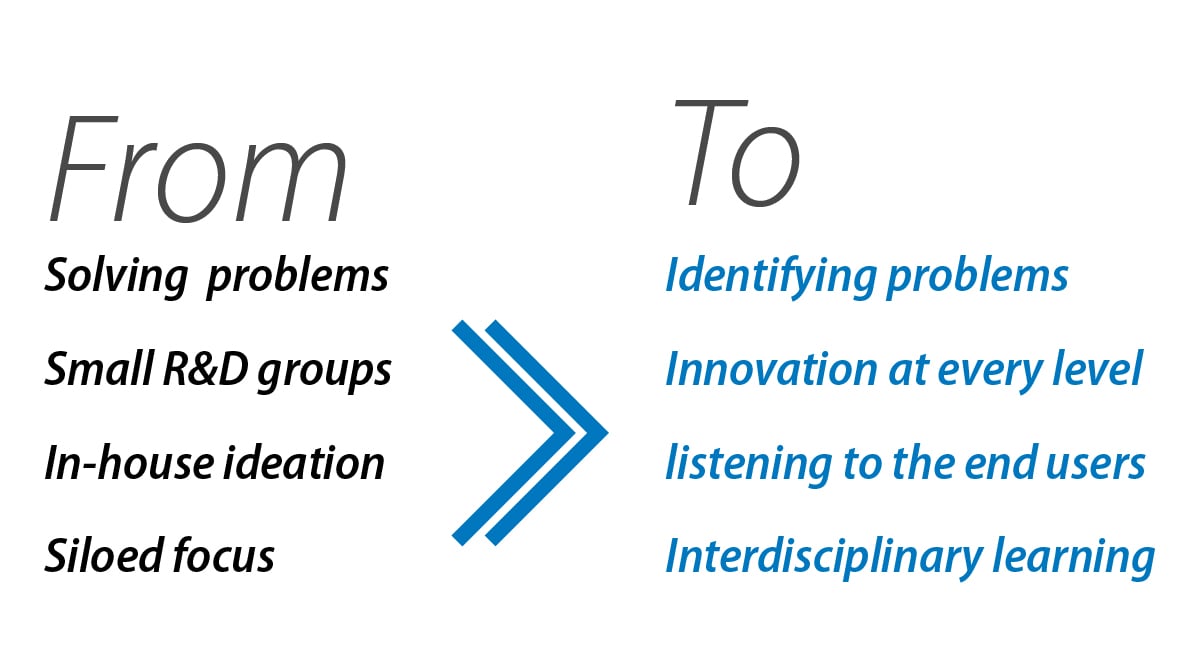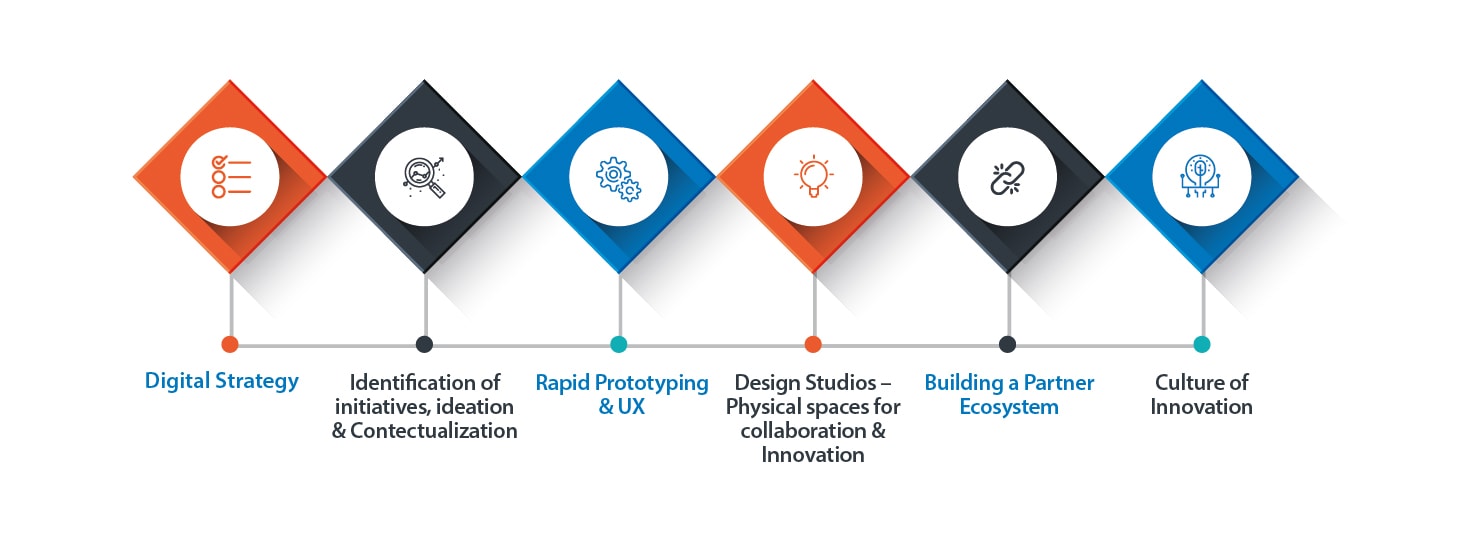Disruptions
The Changing Role of Technology Service Providers
Technology is changing faster than what organizations can cope with. It is critical to not just adopt new technology but to contextualize it to the problems of the business and ensure its successful implementation on the ground. Technology service providers are moving beyond vendor-customer relationship to play the role of a strategic partner in helping organizations get the best out of disruptive technologies.
Businesses are stressed and technology in isolation can’t help them
Disruptive technologies and business models are proving to be game changers in every industry. Driven by the pervasiveness of technology, global connectivity, and ever-increasing competitive pressures, these disruptions are forcing organizations to be future-ready, efficient, and innovative. Organizations have to re-skill, re-tool, and even re-imagine their businesses to survive because today it’s no more a question about their future in the business; but the future of the business itself!
Organizations need help in devising a strategy to make their business future-proof. But strategy alone is not enough. It must be realized on the ground. Today - more often than not - this happens with the help of emerging technologies. However, the number of such new technologies is large and the speed at which they change is even greater. Clients, with their already stretched internal IT departments, are lagging behind in mastering and harnessing these technologies. They are looking at their technology partners to provide ‘Incubation as a Service’ so that they can navigate these disruptions through innovation without risk.
Businesses seek de-risking of innovation
The emphasis has to not only be on building technological capabilities but also on contextualizing them in order to solve business problems or exploit new opportunities. Service providers must partner with clients to not only create strategy but also ensure its successful execution on the ground. This calls for establishing a long term, strategic partnership between client organizations and service providers in place of the legacy vendor-customer relationship.
Most differentiated, high reward innovations are those with a high degree of uncertainty in both business (e.g. new, unproven operating spaces, business models, pricing models, etc.) and technology (e.g. use of emerging technologies). This means that the high-reward offerings are by definition, also the high risk ones. Organizations expect their technology partners to help them de-risk innovations that are led by emerging technology.
Technology service providers are coming up with different approaches to meet these expectations. For example, the Infosys Incubation as a Service program is designed to help clients leverage techniques such as Design Thinking, along with the strong emerging technology skills within Infosys. This significantly extends the comfort zone of our client organizations into the high reward zone giving them an edge over their competitors who continue to remain in the high-risk zone.
How Should Technology Providers Respond to this Expectation?
Technology providers need to pay heed to Management Guru, Peter Drucker’s advice that the bright idea-based innovation is the riskiest with the least success rate and that ‘Innovation is about exploiting change as an opportunity… and is a systematic discipline that can be learned and practiced’. Such an approach is transformative for both the clients and their service providers. Technology service providers must go through key shifts to meet client expectations.

Historically, most IT service providers have played a reactive role, responding to problems that are already identified (often, even the solutions are known beforehand). The focus used to be on building that pre-identified solution in time and within budget. However, the new reality expects IT vendors to play a leading role in identifying the right problems to be solved, and devising and implementing innovative, emerging technology-led solutions.
Likewise, reliance on in-house R&D teams alone must also give way to more distributed innovation at every level.
Another radical shift that is underway is that in-house ideation is being replaced by “listening” (to the end users). The historical practice of leadership-driven innovation must give way to an end-user centric design process. Design Thinking emphasizes the central role the end user holds in that methodology. This approach helps to systematically eliminate wrong assumptions about problem statements and solution designs that can prove costly.
Lastly, it is evident that the underlying patterns in which emerging technologies are applied are portable across domains. The organizations expect the technology providers to identify and harness these patterns for their benefit.
Technology providers need to create for themselves a holistic innovation partner role that encompasses the following dimensions:

Digital Strategy - Helping the client make sense of factors such as a wide range of new technologies, new business models, digital consumers, global competition and a highly competitive marketplace, is a key requirement of that role. Organizations are increasingly looking at technology partners to help them make their digital strategy future-ready.
Identification of initiatives, Ideation and Contextualization – Any innovation intended to realize this strategy on the ground must be based on a systematic identification, ideation and contextualization process. Innovation lies less in the technology itself and more in how the technology is applied to solve a business problem. The technology providers must therefore expand their horizons and be ready to help their clients devise innovative ways in which the technology can be applied.
Rapid Prototyping - The speed at which the market is evolving today compels organizations to be rapid and agile in their response. The ability to quickly create new products and offerings, to fail fast, and to adopt an iterative approach to design are the central expectations organizations have from their technology service providers.
Co-Creation – Technology providers must be ready (with the right talent, infrastructure, logistics and organizational culture) to engage clients in such a way that they can co-create solutions with them.
Partner eco-system – It is imperative that both the organizations and the service providers not rely only on themselves to meet these challenges but also build an ecosystem of partners to maximize the success potential of any innovation.
Culture of Innovation – Lastly, it is essential to nurture a culture of innovation within the ranks of the technology service providers – where people engaging with the clients, at every level, can identify problems and opportunities and come up with innovative responses. Mechanisms, such as hackathons, ideation contests, idea management platforms, rewards programs, as well as training, can be adopted for this purpose.
Key Lessons for the Technology Provider
Technology providers can benefit by keeping the following important lessons in mind when engaging with clients:
- Technology is only a small part of the solution - The challenge of converting an idea into a full business solution is often underestimated and organizations bite off a lot more than they can chew. A successful innovation must factor in a complete view that includes not just technology but also new business models, process changes, hiring or reskilling of talent, and cultural changes in the organization.
- It is often not creating new Technology but contextualizing the existing one that matters - Business owners and customer-facing teams must be part of any innovation and contribute to successful contextualization of technologies. Most innovations leverage multiple technologies, including a mix of established and emerging ones. This makes it even more important that these technologies are brought together in a meaningful manner.
- It is critical to grasp the actual problem - To achieve effective contextualization and application of technologies, it is critical to grasp the actual problem that needs to be solved. This problem could be (and in most cases, is) different from what it is initially assumed to be. As the adage goes, “What gets us into trouble is not what we don't know. It's what we know for sure that just ain't so.”
- The ways in which the emerging technologies are used are often portable across industries - even if the specific use cases are not – For example, dismantling the collection (what iTunes, short denomination recharge for mobiles, and one time use shampoo sachets did), Uberization, and pre-payments (used to onboard a large number of customers without a credit history, this was initially used by cell phone companies, now also by utilities).
- Too much planning is not helpful - It is important to have a bias in favor of action. Fail fast and be iterative. Spending too much time in planning in the expectation that the first iteration will be successful is unrealistic.
- Outside-in perspective is key - Showcasing the innovation from the business angle, in other words, an outside-in perspective, is essential. The value of technology-led innovation is not visible to the business owners unless it is put in the business context and is articulated as such.
- Extreme approaches are not helpful - When implementing, it is important to note that neither a completely centralized, nor a completely decentralized approach works. It is often more effective to have a small, core team that is ensuring the projects taken up for incubation are in line with the organizational objectives. This team should provide directions to the employees at large. Innovation must indeed happen at every level, though it may not happen with every person.
- Core-flex teams work better - A core-flex model means a small ‘core’ team that stays throughout the collaboration and larger, ‘flexible’ teams that are brought together for specific tasks or projects, and disbanded after those are completed. The ‘core team’ ensures that the strategic alignment of the innovation activities is maintained and the learning from the engagement is retained within the team. The flex teams allow different technology skills to be brought in, depending on the idea being incubated.
- Smaller incubation cycles are more effective - Do not let incubation go beyond 12 weeks. If it does, break it into smaller chunks. Proofs of Concept longer than 12 weeks tend to develop the dynamics of a waterfall engagement model.
- Innovation teams are more effective when given a specific problem to solve - It is better to give teams a specific task, such as reducing human error when sorting packages, rather than a high level, vague objective, such as expanding market footprint in Africa.
Conclusion
It is imperative that technology service providers understand the ever-changing client expectations and ready themselves to respond to the same. This process requires some fundamental shifts in the way technology providers have historically operated. Some of these changes are difficult to achieve and require strong organizational determination. Providers must adopt a systematic approach to help clients de-risk innovations, potentially high-reward solutions in a sandboxed, fail-fast, rapid environment, while leveraging Design Thinking and harnessing emerging technologies.




